This is a classic home-canned chutney; a real old-time pleaser.
Tart and sweet, it goes well with pork, turkey, sausage, game, lamb, etc. It’s also good with cheeses and pâtés.
This recipe is from the Ball / Bernardin Complete Book of Home Preserving.
This recipe makes a lot, so you may wish to cut it in half.
Note: The ingredients are simple, but there is a lot of prep work in this recipe that there is no getting away from.
The recipe
If you wish to adjust batch size, do the math first on paper.
Jar size choices: Quarter-litre (½ US pint / 250 ml / 8 oz) OR half-litre (1 US pint / 500 ml/ 16 oz)
Processing method: Either water-bath or steam canning
Yield: 6 x half-litre (US pint) jars
Headspace: 2 cm (½ inch)
Processing time: 10 minutes either size jar
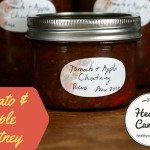
Tomato Apple Chutney
Ingredients
- 2 kg tomatoes (about 4 pounds / 10 cups, chopped and peeled, about 15 large)
- 400 g English cucumber (unpeeled. About 2 cups, chopped. About 1 lb)
- 300 g onion (whole. About 3 small to medium ones, about 1 ½ cups / 10 oz. 350 g / 12 oz whole before peeling.)
- 250 g red bell pepper (seeded, chopped. 1 ½ cups / 8 oz, measured / weighed after seeding and chopping. About 2 medium)
- 500 g apple (peeled, cored, seeded, and sliced. 4 cups / 1 lb)
- 750 ml vinegar (5% or higher, white or cider. 3 cups / 24 oz)
- 500 g brown sugar (3 cups, lightly packed / 18 oz )
- 175 g raisins (about 1 cup / 6 oz)
- 1 hot red pepper (or 1 teaspoon chile flake)
- 1 clove garlic (chopped)
- 1 tablespoon ginger (ground)
- 1 teaspoon pickling salt
- 1 teaspoon cinnamon (ground)
We added the following seasonings to fill out the taste. Your call if you want to use some or any of these.
Instructions
- Get a big pot at least 8 litres / quarts in size. Prep and add to pot all the veg from the tomatoes down to and including the apple. Then add all remaining ingredients. Stir.
- Bring to a boil, then lower to a simmer and cook until the consistency of a thick commercial relish, or it mounds on a spoon. This could be as little as 45 minutes, or up to an hour, or longer, depending on how watery your tomatoes were. (Caution: Add NO starch thickener as that will affect heat penetration during canning and thus safety.)
- Stir frequently, especially in the last half of cooking as it thickens so that it doesn't burn.
- When done, adjust taste with spices or seasoning if desired.
- Pack hot into quarter-litre (½ US pint) jars or half-litre (US pint) jars.
- Leave 2 cm (½ inch) headspace.
- Debubble, adjust headspace.
- Wipe jar rims.
- Put lids on.
- Process in a water bath or steam canner.
- Process either size jar for 10 minutes; increase time as needed for your altitude.
- Best after at least a month of jar time.
Nutrition
Reference information
How to peel tomatoes.
How to water bath process.
How to steam can.
When water-bath canning or steam canning, you must adjust the processing time for your altitude.
For salt substitute, Herbamare Sodium-Free was used.
For stevia, Better Stevia liquid stevia was the stevia used.
More information about Sugar and Salt-Free Canning in general.
Australia and New Zealand vinegar strength special notes.
What is the shelf life of home canned goods?
Recipe notes
- Wash all veggies of course before prepping them.
- Allow about an hour time to assemble all this in the pot; prepping veggies just takes time. If you want to prep all the veggies the day before, store them in fridge overnight in a large covered tub with 250 ml (1 cup) of the vinegar stirred in.
- No need to peel or seed cucumber. English cucumber is specified because most other cucumbers are sold with waxed skins. As the cucumber is not being peeled, you don’t want a waxed skin going into the mixture. If you grow your own cucumber, presumably then your own unwaxed cucumber is fine. If you only have a waxed-skin cucumber to hand, then peel it.
- You can use green, yellow or orange bell peppers if you want.
- How coarse or fine you want to chop the onion and pepper is down to you. The rest will all boil down into moosh so don’t worry about how finely chopped anything else is.
- It will start off being about 6 litres / quarts in volume and then boil down to about half.
- How long the boiling down takes depends on whether you used paste (dry) tomatoes such as Roma, or juicy tomatoes that are usually used for slicing and fresh-eating. With very watery tomatoes, you may need to simmer for up to 2 to 3 hours even to get a good thick spooning consistency. Do not add any thickeners such as flour, cornstarch, etc, or you risk making it unsafe for home canning.
- Instead of the salt, you can use a non-bitter, non-clouding salt sub. We have found Herbamare Sodium-Free to meet those requirements.
- You can reduce the sugar, or use the same volume amount of granulated Splenda®, or use 3 teaspoons of liquid stevia. For stevia, we’d recommend Better Stevia liquid stevia .
- The Ball / Bernardin Complete writers seem concerned about the apple browning, which is why you prep it last and then add the vinegar immediately afterward, though it’s not clear that any browning would make any difference in a dark recipe such as this.
- For a darker chutney, you could try adding 1 to 2 teaspoons of Kitchen Bouquet.
- You can use ½ teaspoon of minced, oil-free garlic from a jar instead of the 1 clove.
Recipe source
Kingry, Judi and Lauren Devine. Ball / Bernardin Complete Book of Home Preserving. Toronto: Robert Rose. 2015. Page 237.
This recipe also appears in:
- Fruit Pickles and Chutney. SP 50-757. Oregon State University Extension Service. February 2013.
- Ball Blue Book. Muncie, Indiana: Healthmark LLC / Jarden Home Brands. Edition 37. 2014. Page 83.
Modifications made:
- Added additional flavouring of cloves, allspice, basil and marjoram.
To make original version, omit cloves, allspice, basil and marjoram.
Nutrition information
Regular version
Per 2 tablespoons / 30 ml
- 40 calories, 97 mg sodium
Sugar and Salt Free Version
Per 2 tablespoons / 30 ml
- 23 calories, 73 mg sodium
- Weight Watchers PointsPlus®: 1 tablespoon, 0 points; 2 to 4 tablespoons: 1 point; 5 to 8 tablespoons: 2 points.
* Nutrition info provided by https://caloriecount.about.com
* PointsPlus™ calculated by healthycanning.com. Not endorsed by Weight Watchers® International, Inc, which is the owner of the PointsPlus® registered trademark.
* Better Stevia ® is a registered trademark of the NOW Foods Company.
* Herbamare ® is a registered trademark of the A. Vogel Corporation.
* Pickle Crisp ® is a registered trademark of the Jarden Corporation.

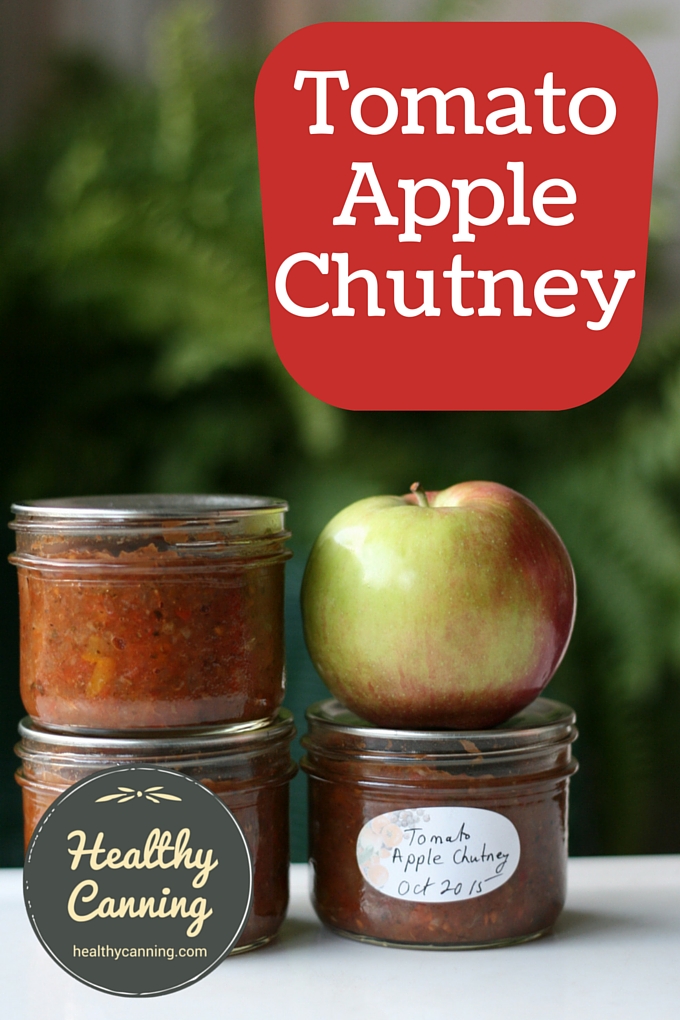
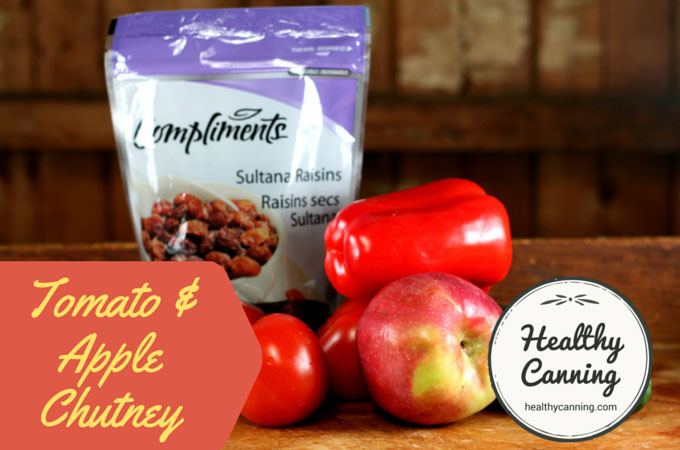
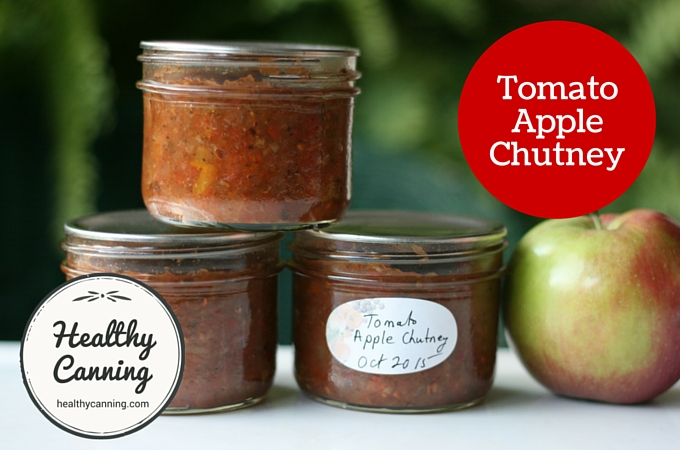
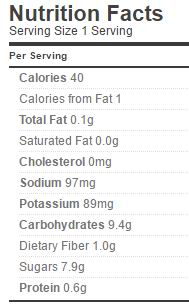
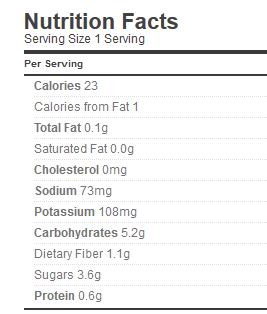
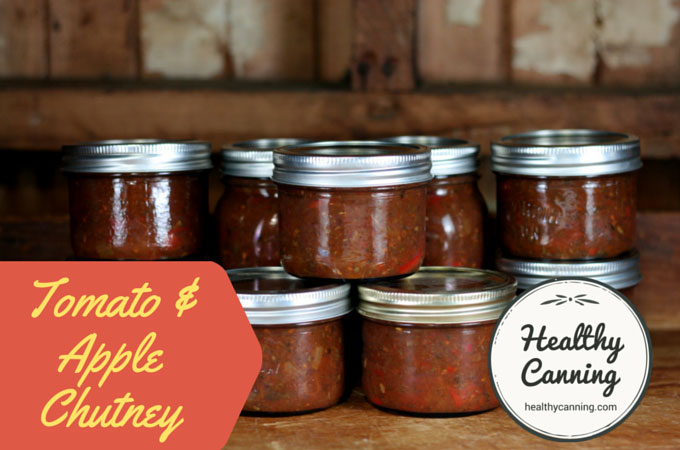
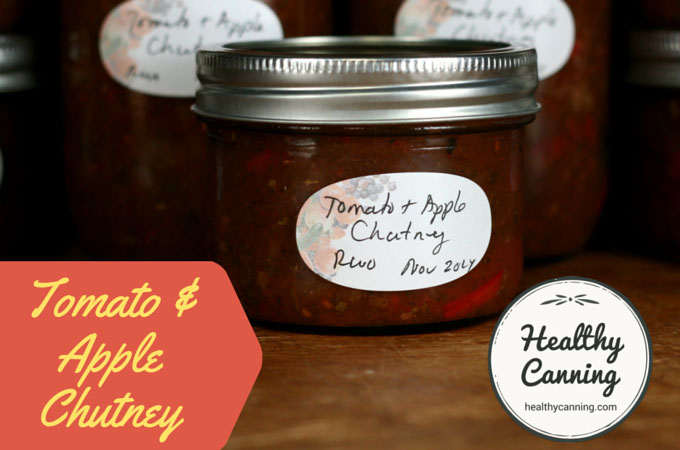
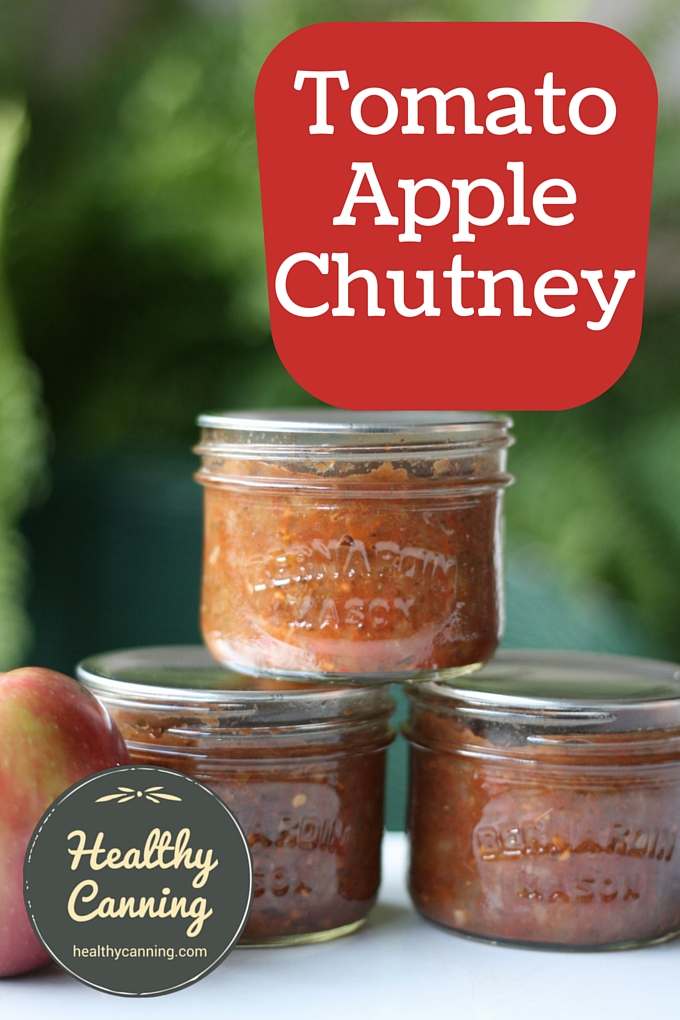
jess
can you use green tomatoes ?
Linda
So could you use canned tomatoes? Just measure the same amount of diced tomatoes or crushed tomatoes? Can you do that in any recipe? I’ve wondered this for ages as tomatoes aren’t cheap where I live.
Healthy Canning
For this recipe, you would want about 10 cups / 2 1/2 litres of canned tomatoes. Include the juice from the cans. You’re going to be boiling the tomatoes down anyway to a sauce inside the mixture. Note that the suggested simmering times are just guesstimates; focus on reaching the various thickness stages suggested.
Tracy
Hi, can cucumber be omitted? Thanks
Healthy Canning
Omitting the cucumber wouldn’t pose any concerns from a safety point of view.
Angela
Hi! Can you use sundried tomatoes for this recipe too? Thanks 🙂
Healthy Canning
Gosh, not sure. At first blush, I would think that if one didn’t have access to affordable fresh tomatoes at the time, that canned crushed or diced tomatoes might be a better option than starting from dried, as the canned stuff would provide the liquid for the simmering phase. You can ask Ball or Bernardin, but I suspect the math on that kind of substitution (dehydrated for fresh) would be tricky to both rehydrate and have enough for simmering that they will probably just say “no.” But you can see what they say! Maybe it will at least inspire them in the future to provide recipes drawing on dried tomato.